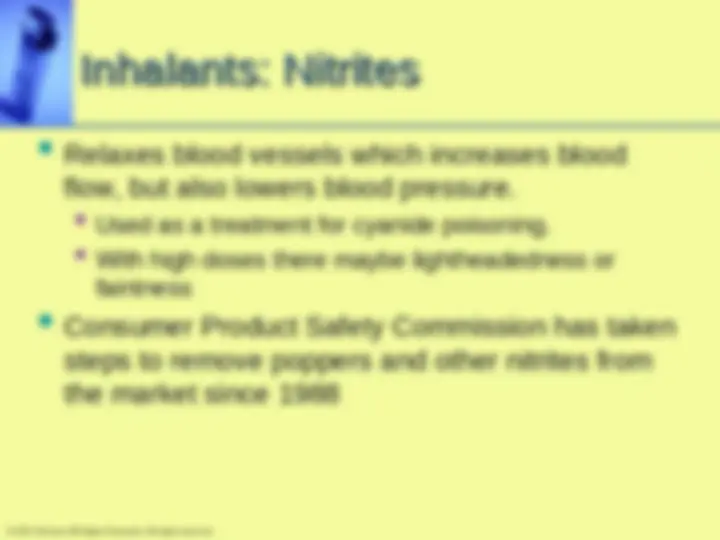



























Study with the several resources on Docsity

Earn points by helping other students or get them with a premium plan


Prepare for your exams
Study with the several resources on Docsity

Earn points to download
Earn points by helping other students or get them with a premium plan
Community
Ask the community for help and clear up your study doubts
Discover the best universities in your country according to Docsity users
Free resources
Download our free guides on studying techniques, anxiety management strategies, and thesis advice from Docsity tutors
Drug Edu Chapter 7 PPT Material Type: Notes; Class: Community Health; Subject: Health; University: Minnesota State University-Mankato; Term: Forever 1989;
Typology: Study notes
1 / 33

This page cannot be seen from the preview
Don't miss anything!


























(^) Include prescription drugs that treat anxiety
(^) As a group, also called sedative-hypnotics (^) Alcohol is the most widely used depressant (^) Benzodiazepines are the most widely
(^) Chloral hydrate (“knockout drops,” “Mickey Finn”)
(^) Paraldehyde
(^) Bromides
appeared in OTC drugs through the 1960s
(^) Discovery/introduction
be used clinically
amobarbital and secobarbital (^) Grouped on the basis of the time of onset and
anxiety
sleep
(^) Ultra-short acting barbiturate (^) Administered intravenously (^) Used as an anesthetic for brief surgical
(^) Moves very rapidly into the brain (^) Also used to make people relaxed and talkative
(^) Thiopental is currently the first of the three drugs
(^) 1960: Introduction of chlordiazepoxide (Librium),
other depressants like alcohol (^) 1970s: Diazepam (Valium), a lower-dose
(^) Dependence and overdose can occur; dosage
doses
have a rapid onset of effects
a short duration of action (^) More differences among the barbiturates and
(^) Benzodiazepines and barbiturates
(^) Nonbenzodiazepine hypnotics
antianxiety drugs
eszopiclone (Lunesta)
(^) Concerns about use of sedatives as anxiolytics:
others seem to be treated more effectively by antidepressants or behavior therapy
(^) Is a person taking the drug to treat a disorder or to feel better in a general way?
(^) As sleeping pills
hypnotic drug helps a person get to sleep more quickly
although people sometimes overestimate its severity
prescribed than in the past, and they are usually taken for only a few nights at a time
(^) Zolpidem (Ambien) binds selectively to
(^) Rapid onset and short duration of action (^) Concern about people driving while still under the influence (from not allowing 8 hours of sleep after taking drug) (^) Eszopiclone (Lunesta) (^) Approved for long-term use
temperature and noise
something relaxing before trying to fall asleep again